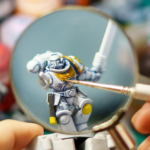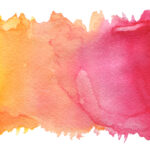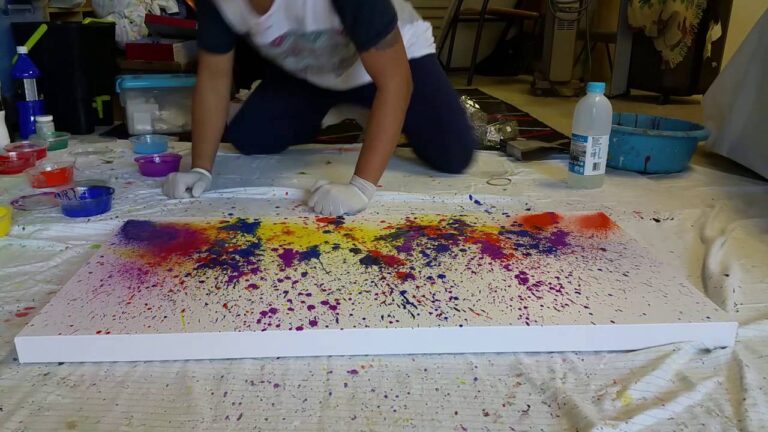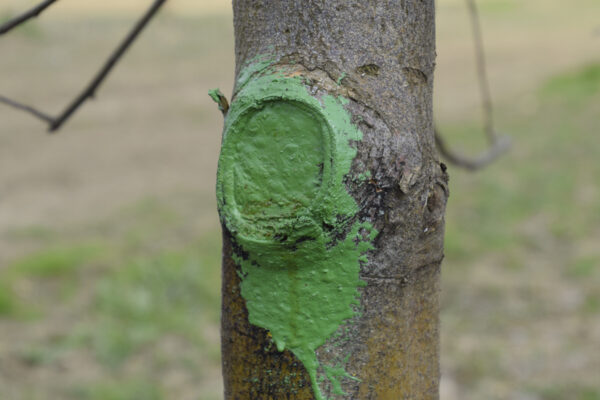Table of Contents
Spit painting might sound odd, but it’s a captivating world within the arts. Unlike traditional methods, where precision is key, spit painting thrives on unpredictability and raw emotion.
At its core, it’s about blending saliva with paint, creating unique textures and patterns. This technique is about the final artwork and the journey of building it. It’s a dance of spontaneity where the unexpected is welcome.
As the artist combines their inner vision with the fluidity of the paint, each creation tells a distinct tale. Dive into this mesmerizing realm, where every droplet of color echoes an artist’s heartbeat.
Safety First: Preparing for Spit Painting
Embarking on the spit painting journey requires a well-prepared space. Prioritize a well-ventilated area to combat potential paint fumes. Shield floors and nearby items from unexpected splatters using protective covers.
Location Selection: Spaces with proper ventilation are crucial, especially given the fumes that some paints might release. Always choose an open area.
Surface Protection: Protect your surroundings by laying down newspapers or plastic sheets, ensuring stray droplets don’t mar the surroundings.
Organized Materials: An artist’s workstation speaks volumes about their method. Ensure that your paints, brushes, and other necessities are easily accessible.
Wear Protective Gear: Art can be messy. Wear an apron or old clothes, and consider gloves if you’re working with more toxic paints.
Emergency Provisions: Unexpected spills or splashes can occur. Be prepared with tissues, wipes, and a basic first aid kit.
Understanding the Basics: What is Spit Painting?
Spit painting embodies the raw essence of emotion, a dance between chaos and intention. It’s where nature’s unpredictability meets the human touch, crafting abstract tales in vivid hues. This art captures the spontaneous spirit, fusing breath and pigment in an unscripted ballet.
Concept: The technique involves diluting the paint with saliva and applying it to a canvas or surface, often resulting in a unique texture and blend.
Origins: While it’s hard to pinpoint the exact roots, there’s a belief that spit painting emerged from ancient tribal customs, symbolizing a deep connection between the artist and their work.
Selecting Your Paint: Making the Right Choice
Selecting the right paint is paramount in spit painting. The texture, consistency, and hue can transform when mingled with saliva, creating unexpected and mesmerizing results. An informed choice ensures that the artist’s vision translates seamlessly onto the canvas.
Watercolors: Due to their easy dilution, watercolors are often the top choice, offering a gentle blending effect.
Acrylics: When thinned appropriately, acrylics can pop vibrantly on the canvas.
Inks: A slightly more fluid option, inks offer a distinct aesthetic and fluidity.
Getting Started: The Spit Painting Technique
Diving into spit painting means immersing oneself in a world where fluid dynamics and artistic intent coalesce. Each droplet and smear introduces a novel dimension, turning the canvas into a dynamic tapestry of organic interplay.
Mixing: Your saliva acts as the diluting agent. The ratio, however, depends on the artist’s preference and the desired consistency.
Application: Techniques can vary from using brushes and fingers or directly spitting onto the canvas to create unpredictable patterns.
Texture and Patterns: The beauty of spit painting is in its randomness, often leading to mesmerizing abstract patterns.
Embracing the Chaos: The Beauty of Abstract
Randomness is celebrated in spit painting, turning the unpredictable into masterful passion strokes. The canvas becomes an arena where control is relinquished, letting the abstract tales of color and form emerge organically. This art transforms the chaos itself, channeling raw feelings into a visual symphony of spontaneity.
Unpredictability: With no two paintings ever the same, each piece is a unique testament to the artist’s state of mind and the capriciousness of the method.
Color Fusion: How colors merge, blend, and sometimes clash creates a vibrant spectacle on the canvas.
Sealing Your Masterpiece: Protecting Your Artwork
After the fervor of creation, shielding your spit painting from the elements and time’s touch is essential. Applying the right sealant ensures that the vividness of your colors and the intricacies of your design remain intact. It’s the final step in the artist’s journey, encapsulating the chaos and beauty beneath a protective embrace, preserving your masterpiece for future admiration.
Varnishing: A good varnish protects against wear and tear and potentially damaging UV rays.
Framing: Framing enhances the visual appeal and adds an additional protective layer against external elements.
Artistic Variations: Exploring Different Styles
Spit painting, like any other art form, can be approached in a variety of styles, each one offering a unique experience and outcome. From monochromatic minimalism to explosive, vibrant patterns, artists can explore the spectrum of creativity. It’s essential to remember that beauty lies in the artist’s interpretation and the journey of expression.
Materials and Tools: Beyond the Basics
While the primary focus of spit painting revolves around the paint and saliva, including different tools can add depth and variation to the piece. Experimenting with brushes of various sizes and spatulas and even incorporating unconventional tools like toothbrushes can lead to astounding textures and patterns. Diverse materials can also serve as canvases, from fabrics to wood, further expanding possibilities.
Conclusion
Spit painting shines brightly as an unexpected star in the expansive universe of artistic expression. Its raw, unconventional approach celebrates the infinite horizons of creativity. By championing unpredictability and the abstract, spit painting is a poignant reminder that authentic artistry doesn’t always fit into neat boxes. Instead, it often finds its most profound voice when dancing along the edges of tradition, urging us to see beauty in the uncharted and unfamiliar.
FAQ’s
Is spit painting safe?
Yes, especially with non-toxic paints. Yet, always ensure good ventilation.
Can I use any paint for spit painting?
Preferred paints are watercolors, acrylics, and inks, but testing different paints can lead to exciting results.
Why use saliva instead of water?
Saliva offers a different consistency and can impact texture and drying time differently than water.
How long does spit painting take to dry?
Depending on the paint type and application thickness, drying times can vary but are generally quicker due to the thinner consistency.
Is there a significant cultural history to spit painting?
While its origins remain debated, some suggest it has links to ancient tribal rituals, representing a profound bond between the artist and their creation.

I am a true enthusiast of all things painting, with a deep appreciation for the versatility and limitless possibilities of paint, and I am always eager to experiment with new techniques and styles and share that with my readers.






![How to Hold a Paint Palette [Step-by-Step]](https://paintersbest.com/wp-content/uploads/2023/02/paint-palettes-iStock-1244865651-1-16a59c0-600x400.jpg)

